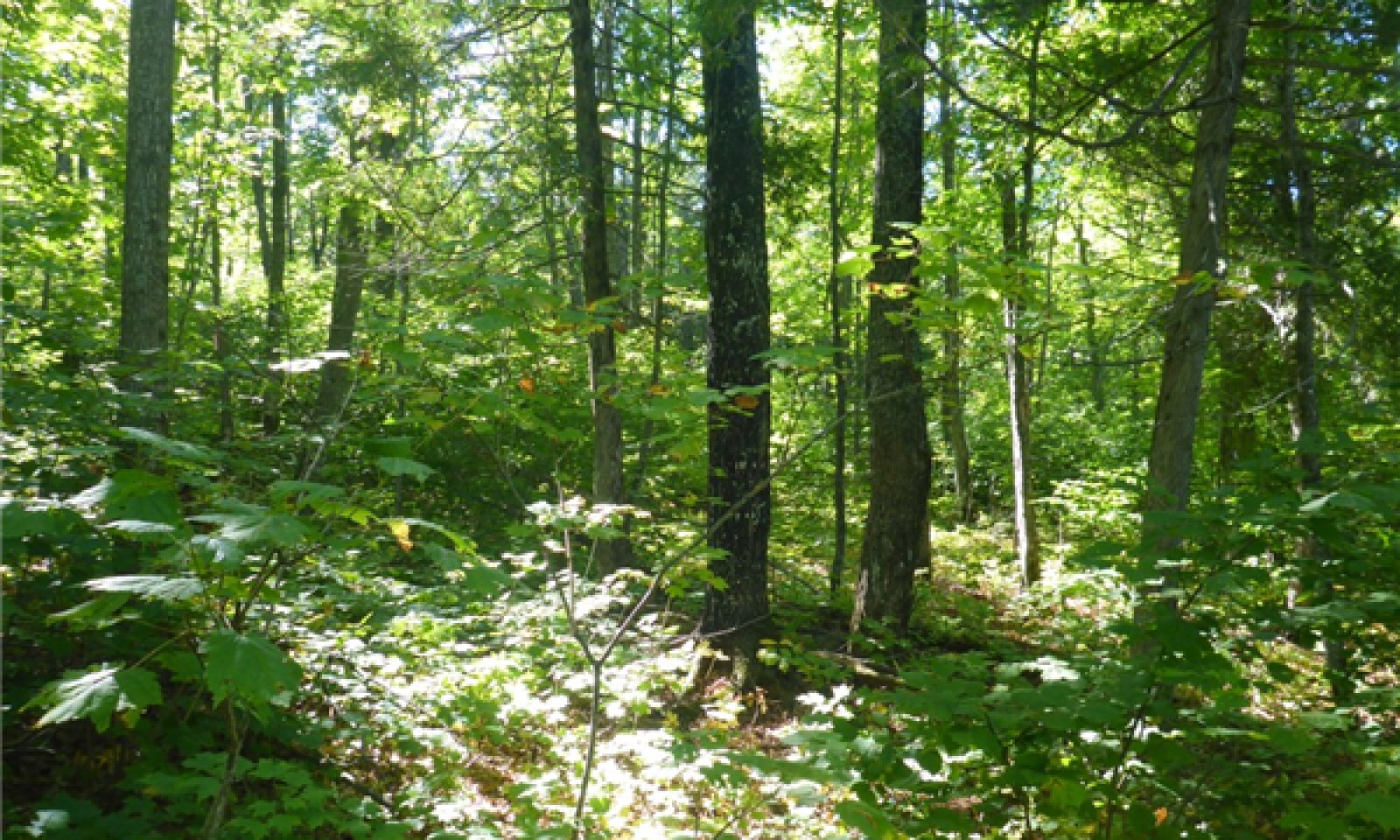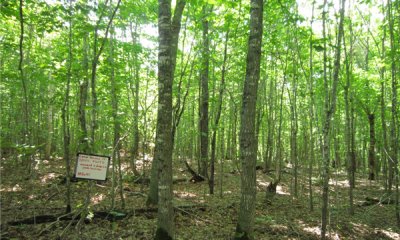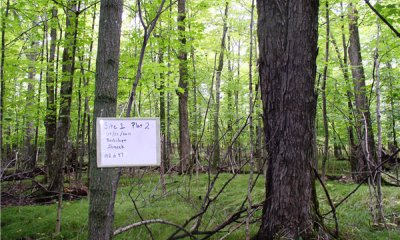
Loamy Upland
Scenario model
Current ecosystem state
Select a state
Management practices/drivers
Select a transition or restoration pathway
-
Transition 1A
Selective/intensive logging
More details -
Transition 1B
Clearcut
More details -
Restoration pathway 2A
Long term succession
More details -
Transition 2C
Clearcut
More details -
Transition 2B
Introduction of exotic earthworms or heavy browse.
More details -
Restoration pathway 3A
Succession
More details -
Transition 3C
Succession
More details -
Transition 3B
Introduction of exotic earthworms or heavy browse.
More details -
No transition or restoration pathway between the selected states has been described
Target ecosystem state
Select a state
Description
Community phases within the Reference State follow classic successional trajectories. Although we document this historical range of variability, late-successional closed canopy, multistoried forests were the dominant condition during pre-settlement (Landfire 2007, MN DNR 2013, MN DNR 2005). Sugar maple is the most influential species and can even be co-dominant in the early-successional community phase following intense blowdown events due it is ability to accumulate in all layers of the forest understory as advance regeneration. However, if such blowdown events are followed by a combination of drought and fire, trembling aspen (Populus tremuloides) and paper birch will be favored (Frelich 1999, Natureserve 2007). Although these events did happen and are possible today, due to the historically infrequent nature of such events we do not describe a separate early-successional community phase. By the mid-successional community phase the canopy is closed and sugar maple and yellow birch begin to take over. The early stages of the late-successional community phase continue to be dominated by sugar maple and yellow birch, but with shade tolerant conifers beginning to take hold (such as northern white cedar, white spruce, and balsam fir). Without broad scale blowdown events, community phase 1.1 is almost self-perpetuating; continuing to favor the most shade tolerant, fire intolerant species. The major regenerating disturbance mechanism is by small scale treethrow events which provides habitat for forest interior wildlife, microsites for tree regeneration, and opportunity for some disturbance-adapted species to maintain themselves (such as beaked hazelnut; Kabrick et al. 1997, Landfire 2007). Coupled with this is the accumulation of coarse woody debris in the way of snags and downed wood in various sizes and levels of decomposition (Hale et al. 1999). In advanced stages of old growth (not described in detail here) there is some indication that sugar maple begins to decline while these conifers ultimately increase in importance (MN DNR 2013b).
Today good examples of the Reference State are rare. However, some do exist in a few state parks or natural areas, largely limited to northern populations within large intact landscapes having high biological significance. Post-settlement logging and contemporary forest management in part mimic early- and mid-successional dynamics, and are much more common today.
Submodel
Description
This was the most common state that followed the pre-settlement forests, and may be the most common today. In general, forests on this ecological site were not completely cleared like other forests in the Great Lakes states (as in many coniferous forest types). This was largely due to the abundance of sugar maple which was not a sought after species, and partially because maple (and other hardwoods) could not be easily transported along waterways (Johnson et al.2009). Instead, destruction of reference communities came in the way of selective logging of sought after species of adequate size (i.e., high-grading). This occurred in numerous pulses, with large white pine and yellow birch being removed initially, which likely accounts for the limited occurrence and/or decline of these species today. In many cases, overstory vegetation turned into monotypic sugar maple stands, while in other cases some level of diversity in the overstory was secured, although probably less than before. These two situations represent each of the community phases within this state. Like the reference state, these forests tend to be uneven-aged and with natural succession or thoughtful silviculture (e.g., retention of snags, poor quality trees, etc.) it may be possible to restore some sites to reference conditions (Hale et al. 1999).
Communities in this state are a common occurrence on the modern landscape, particularly in private landholdings which tend to be unmanaged. Today, depending on the specific location there may be early stages of earthworm invasion (e.g., Dendrobaena octaedra) as well as some elevated deer browse, but not enough to push it into the Invaded State (which is described below).
Submodel
Description
Clearcutting in state 1, or more typically in state 2, will convert the community to an even-aged stand which produces an uncharacteristic, age structure for this ecological site. However, community phases within this state can be similar to community phases 1.2 and 1.3 from the reference state, particularly in terms of stand structure. Communities in this state are most common in managed forest settings where forest managers often have goals of improving the sugar maple quality as well as providing better wildlife habitat for various game species, such as white-tailed deer and ruffed grouse (Bonasa umbellus, Tubbs 1977). Besides the occasional paper birch or localized thicket of trembling aspen, the result is generally a dense monotypic stand of sugar maple (Paul Moran, MN DNR Forester, personal communication). As the stand matures opportunities for management and restoration to states 1 or 2 develop.
There may be early stages of earthworm invasion (e.g., Dendrobaena octaedra) as well as some elevated deer browse in this state, but not enough to significantly alter vegetation or dynamic soil properties. This state is a common occurrence on the modern landscape, particularly in managed, publicly-owned forestland.
Submodel
Description
The Invaded State is the furthest removed from the Reference State and can transition here from either state 2 or state 3 following long term heavy deer browse or advanced stage earthworm invasion from Aporrectodea spp. and/or Lumbricus spp. This state is more common throughout the southwestern part of this ecological site’s distribution, where habitat fragmentation and human development are prevalent. Stands in this state can be either even-aged following clearcutting or uneven-aged following selective logging.
Herbivory by deer affects both woody and herbaceous vegetation by direct consumption of plant material. In areas of high deer densities sugar maple may become even more favored due to preferential browsing of other woody species, such as yellow birch and northern white cedar (Rooney and Waller 2003). Deer herbivory by itself has the potential to cause extirpation of the most preferred, palatable species, such as those in the lily family (Augustine and Frelich 1998). In extreme cases, vegetation can become so sparse it is possible that changes in soil moisture, soil temperature and dynamic soil properties may occur, such as a reduction in soil organic carbon which may result in a decline in soil moisture or increase in soil temperature. Overall, elevated herbivory can result in distorted vegetation composition and structure in the forest understory (Alverson et al. 1988, Augustine and Frelich 1998) and indirectly alter the trajectory of the entire forest ecosystem, thus creating novel, deer-induced natural communities affecting vegetation as well as wildlife patterns (Rooney and Waller 2003, White 2012).
Due to the rich soils and lush vegetation, this ecological site, and mesic hardwood forests in general, are the most susceptible forest types to earthworm degradation (Frelich et al. 2006). The type of leaf litter (e.g., sugar maple, American basswood, etc.) these forests produce has high nutritional value in comparison to the drier and less nutrient rich pine, oak, and spruce-fir forests (Frelich et al. 2006, Godman et al. 1990). In previous states, the organic surface horizons may or may not have been affected by the epigeic (i.e., above the soil surface) Dendrobaena octaedra species of earthworm. This species does not by itself cause transition to the invaded state because it only affects the organic surface horizons, which happens by mixing the Oa (i.e., well decomposed) and Oe (i.e., partly decomposed) horizons, but leaving the Oi (i.e., recent litter) intact (Frelich et al. 2006). The advanced stages of earthworm invasion include the presence of D. octaedra as well as the deeper burrowing endogeic (i.e., beneath the soil surface) species in the Aporrectodea and Lumbricus genera, which cause the most significant dynamic soil property changes (Hale et al. 2006, Loss et al. 2013). Aporrectodea and Lumbricus species completely consume the organic surface horizons and incorporate that material into the upper mineral soil horizons (Frelich et al. 2006), producing an uncharacteristic bloated A horizon, along with mixing of any existing E horizons.
In earthworm-free forest soils, there tends to be a net increase in organic material on the soil surface (Great Lakes Worm Watch 2013). In comparison, in the advanced stages of earthworm invasion all this organic material can be completely removed within 3-5 years, making the only input of organic material from new leaf litter each fall, which is quickly consumed, leaving bare soil at the surface by the next fall (Great Lakes Worm Watch 2013). This process completely alters the nitrogen cycle (which is ultimately depleted from leaching) and produces an unnaturally dense, pan-like layer similar to what happens in plowed agricultural soils (Frelich et al. 2006). Changes in dynamic soil properties such as loss of the organic surface along with higher bulk densities in the subsoil could produce drier growing conditions for plants, affecting the ability for characteristic native species to persist. The loss of the organic surface can also expose tree roots, potentially causing long term effects on the life and/or health of trees. However, immature trees (i.e., saplings and seedlings) are likely to be the most at risk to root exposure. Sugar maple seedlings in particular decrease dramatically as a result of earthworm invasion (Hale et al. 2006). Plant seeds are also affected, as the duff layer provides insulation from hot and cold weather extremes and protection from predation by small mammals and birds (Great Lakes Worm Watch 2013). Another negative consequence of advanced earthworm invasion is the effect on important soil bacterial and fungal networks, including symbiotic mycorrhizae, which facilitate essential water and nutrient uptake to many native plant species (Great Lakes Worm Watch 2013).
Advanced earthworm invasion results in a dramatically altered plant rooting environment, both physically and chemically. Some species are able to handle these changes, while others are not. Pennsylvania sedge (Carex pennsylvanica), one of the few non-mycorrhizal species, along with wild leeks (Allium tricoccum) and jack-in-the-pulpit (Arisaema triphyllum), which produce toxic secondary chemicals hazardous to herbivores (and may be avoided by earthworms too), have been shown to increase in these situations (Frelich et al. 2006, Holdsworth et al. 2007). In comparison, other species like largeleaf aster and wild sarsaparilla tend to decrease (Holdsworth et al. 2007, Great Lakes Worm Watch 2013). Although earthworms do not kill canopy trees, it is expected long term recruitment will be affected, particularly in the sapling stage. This may cause elevated sunlight to the forest floor increasing the likelihood for dry-mesic, mid-tolerant species to establish (Frelich et al. 2006).
Ultimately, the interaction of both heavy deer browse and advanced stage earthworm invasion results in extremely degraded conditions, potentially paving the way for other invasive, exotic species such as common buckthorn (Rhamnus cathartica), honeysuckle (Lonicera tartarica, L. morrowii, L. x bella spp.), and garlic mustard (Alliaria petiolata; as represented in community phases 4.3 and 4.4. Overall, the combined effects of invasion by deer, earthworms and exotic plants can initiate an ecosystem decline syndrome that can negatively affect all parts of the ecosystem, from overstory structure, to forb diversity, soil properties, bacteria, fungi, insects, birds, reptiles, amphibians, and mammals. Sites near larger cities, heavily-used lakes, or other developed areas are particularly susceptible to the combination of deer, earthworm, and invasive vegetation problems. Currently, we do not believe any community phases with advanced earthworm invasion can be restored. More research on this topic is needed.
Submodel
Mechanism
Selective/intensive logging (high-grading) of healthy, large diameter conifers and yellow birch.
Mechanism
Clearcut, mechanical removal of all or nearly all trees.
Mechanism
Long term succession (>120 years without disturbance), including a diversity of canopy species (e.g., yellow birch, American basswood, white spruce, white pine, etc.) from natural or artificial regeneration along with recovery of relevant herbaceous species indicative of the reference state.
Mechanism
Clearcut, mechanical removal of all or nearly all trees.
Mechanism
Introduction of exotic earthworms (particularly Aporrectodea spp. and Lumbricus spp.) or heavy deer browse.
Mechanism
Succession (>75 years without disturbance), diversity of canopy species (e.g., yellow birch, American basswood, white spruce, white pine, etc.) from natural or artificial regeneration along with recovery of relevant herbaceous species indicative of the reference state.
Mechanism
Succession (>75 years without disturbance), monotypic maple stands.
Model keys
Briefcase
Add ecological sites and Major Land Resource Areas to your briefcase by clicking on the briefcase (![]() ) icon wherever it occurs. Drag and drop items to reorder. Cookies are used to store briefcase items between browsing sessions. Because of this, the number of items that can be added to your briefcase is limited, and briefcase items added on one device and browser cannot be accessed from another device or browser. Users who do not wish to place cookies on their devices should not use the briefcase tool. Briefcase cookies serve no other purpose than described here and are deleted whenever browsing history is cleared.
) icon wherever it occurs. Drag and drop items to reorder. Cookies are used to store briefcase items between browsing sessions. Because of this, the number of items that can be added to your briefcase is limited, and briefcase items added on one device and browser cannot be accessed from another device or browser. Users who do not wish to place cookies on their devices should not use the briefcase tool. Briefcase cookies serve no other purpose than described here and are deleted whenever browsing history is cleared.
Ecological sites
Major Land Resource Areas
The Ecosystem Dynamics Interpretive Tool is an information system framework developed by the USDA-ARS Jornada Experimental Range, USDA Natural Resources Conservation Service, and New Mexico State University.






